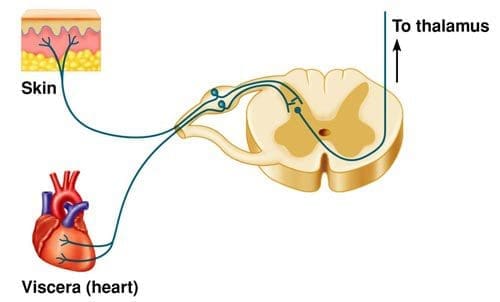Table of Contents
Introduction
In the body’s upper half, the cardiovascular system’s heart helps pump nutrient-riched oxygenated blood all around the body to the corresponding muscles, tissues, and organs to keep the body functional. The heart is protected by the ribcage and muscles surrounding the heart organ from any external factors that can cause harm to the body. When these factors do cause an effect on the body, it can lead to many issues like thoracic back pain, cardiovascular problems, gut disorders, and even chest pains. These issues affect a person, causing them to feel crummy and dampen their outlook. Today’s article will look at chest pains, how it affects the gut and heart in the body, and how viscerosomatic dysfunction is associated with chest pains. We refer patients to certified, skilled providers specializing in osteopathic and cardiovascular treatments that help those suffering from chest pains and cardiovascular disorders. We also guide our patients by referring to our associated medical providers based on their examination when it’s appropriate. We find that education is critical for asking insightful questions to our providers. Dr. Alex Jimenez DC provides this information as an educational service only. Disclaimer
Can my insurance cover it? Yes, it may. If you are uncertain, here is the link to all the insurance providers we cover. If you have any questions or concerns, please call Dr. Jimenez at 915-850-0900.
What Are Chest Pains?
Have you noticed your heart is beating irregularly? How about acid reflux that is affecting your chest constantly? Have you felt muscle stiffness or tenderness in the middle regions of your back? Or have you felt your chest harden and stiffen after something impacted you? Many of these symptoms are tell-tale signs of you experiencing chest pains in your upper body. Research studies have defined chest pains as a common type of visceral pain that is a dull, deep pressure that squeezes the chest. This results in the visceral afferent nerves aggravated as they cause shoulder pain, jaw pain, or thoracic back pain since the nerve root reaches the spinal cord. Additional research studies have found that chest pains can have a variety of cardiac disorders as they can cause dysfunction in the muscles and skeletal joints within the chest walls or the thoracic regions of the spine. When the thoracic region of the spine becomes affected due to chest pains, it can cause herniation on the spinal discs, thus resulting in unwanted pain and discomfort to the individual. Chest pain can even affect the gut system and the heart itself.
How Does It Affect The Gut & The Heart?
Research studies have mentioned that chest pains can affect the gut system and the heart organ itself due to environmental changes that can affect the gut system. The gut microbiota helps metabolize homeostasis in the body for the gut system. When the gut has been impaired, the harmful bacteria travel through the systemic circulation and heighten the inflammatory effects that cause the development of cardiovascular diseases in the heart. At the same time, additional research studies have mentioned that any symptoms accompanying angina pain are conceptualized as a warning to individuals developing coronary artery disease. When this happens, not all ischemic episodes in the heart are indistinguishable when it comes to chest pains and can result from abnormalities of the thoracic regions.
Viscerosomatic Reflexes Overview-Video
Have you experienced irregular chest pains that pop up randomly? How about discomfort in the thoracic regions of your back? Do you feel gastrointestinal inflammatory issues like acid reflux or IBS (irritable bowel syndrome) cause you pain? These symptoms are associated with chest pains in the body due to viscerosomatic dysfunction. Research studies have found that visceral pain is a complex disorder since it can affect one internal organ in the body. In contrast, the corresponding nerve or muscle gets involved as well. Visceral pain is also associated with GI disturbances and changes in the body’s temperature, blood pressure, and heart rate, which are considered autonomic signs that the body is dysfunctioning. The video above gives an insightful overview explanation of what the viscerosomatic reflexes and nerves do when they are not aggravated.
Viscerosomatic Dysfunction Associated With Chest Pains
Since visceral pain is complex and can affect the internal organs, research studies have found that viscerosomatic dysfunction in the thoracic-upper abdominal regions can cause the thoracic and esophagus to become hypersensitive to environmental factors that irritate the airways that connect the entrance of the gut to the esophageal tube. Additional research studies have even found that non-cardiac chest pains are another form of viscerosomatic dysfunction that causes the esophageal opening of the stomach to become dysmotility and hypersensitive causing gastroesophageal reflux disease. This causes many individuals to develop chest pains and can affect a person’s mortality. Adjusting certain habits affecting the chest, gut, or back can reduce the effects that viscerosomatic dysfunction is causing to the person’s body so that they can get their sense of purpose back.
Conclusion
The body’s upper half has the cardiovascular system, where the heart makes sure to pump blood and nutrients to every muscle, tissue, and organ required to keep the body functional. When environmental factors cause issues affecting the body, it can cause various problems in the gut, chest, and heart; this is known as visceral pain and is a complex disorder that can affect the upper abdominal-thoracic region of the body. Visceral pain can cause the gut system to develop gastroesophageal reflux disease, chest pains, and cardiovascular disorders that can make the thoracic region of the spine herniated and stiff if it is not taken care of. When individuals start to take care of themselves and reduce the visceral pain from the affected organ, their bodies will begin to heal naturally and make them continue their health and wellness journey.
References
Brumovsky, P R, and G F Gebhart. “Visceral Organ Cross-Sensitization – an Integrated Perspective.” Autonomic Neuroscience: Basic & Clinical, U.S. National Library of Medicine, 16 Feb. 2010, https://www.ncbi.nlm.nih.gov/pmc/articles/PMC2818077/.
Börjesson, M. “Visceral Chest Pain in Unstable Angina Pectoris and Effects of Transcutaneous Electrical Nerve Stimulation. (TENS). A Review.” Herz, U.S. National Library of Medicine, Apr. 1999, https://pubmed.ncbi.nlm.nih.gov/10372297/.
Johnson, Ken, and Sassan Ghassemzadeh. “Chest Pain – StatPearls – NCBI Bookshelf.” In: StatPearls [Internet]. Treasure Island (FL), StatPearls Publishing, 1 Aug. 2021, https://www.ncbi.nlm.nih.gov/books/NBK470557/.
Sikandar, Shafaq, and Anthony H Dickenson. “Visceral Pain: The Ins and Outs, the Ups and Downs.” Current Opinion in Supportive and Palliative Care, U.S. National Library of Medicine, Mar. 2012, https://www.ncbi.nlm.nih.gov/pmc/articles/PMC3272481/.
Stochkendahl, Mette J, et al. “Diagnosis and Treatment of Musculoskeletal Chest Pain: Design of a Multi-Purpose Trial.” BMC Musculoskeletal Disorders, BioMed Central, 31 Mar. 2008, https://www.ncbi.nlm.nih.gov/pmc/articles/PMC2315652/.
Tang, W H Wilson, et al. “Gut Microbiota in Cardiovascular Health and Disease.” Circulation Research, U.S. National Library of Medicine, 31 Mar. 2017, https://www.ncbi.nlm.nih.gov/pmc/articles/PMC5390330/.
Disclaimer
Post Disclaimer
Professional Scope of Practice *
The information on this blog site is not intended to replace a one-on-one relationship with a qualified healthcare professional or licensed physician and is not medical advice. We encourage you to make healthcare decisions based on your research and partnership with a qualified healthcare professional.
Blog Information & Scope Discussions
Welcome to El Paso's Premier Wellness and Injury Care Clinic & Wellness Blog, where Dr. Alex Jimenez, DC, FNP-C, a board-certified Family Practice Nurse Practitioner (FNP-BC) and Chiropractor (DC), presents insights on how our team is dedicated to holistic healing and personalized care. Our practice aligns with evidence-based treatment protocols inspired by integrative medicine principles, similar to those found on this site and our family practice-based chiromed.com site, focusing on restoring health naturally for patients of all ages.
Our areas of chiropractic practice include Wellness & Nutrition, Chronic Pain, Personal Injury, Auto Accident Care, Work Injuries, Back Injury, Low Back Pain, Neck Pain, Migraine Headaches, Sports Injuries, Severe Sciatica, Scoliosis, Complex Herniated Discs, Fibromyalgia, Chronic Pain, Complex Injuries, Stress Management, Functional Medicine Treatments, and in-scope care protocols.
Our information scope is limited to chiropractic, musculoskeletal, physical medicine, wellness, contributing etiological viscerosomatic disturbances within clinical presentations, associated somato-visceral reflex clinical dynamics, subluxation complexes, sensitive health issues, and functional medicine articles, topics, and discussions.
We provide and present clinical collaboration with specialists from various disciplines. Each specialist is governed by their professional scope of practice and their jurisdiction of licensure. We use functional health & wellness protocols to treat and support care for the injuries or disorders of the musculoskeletal system.
Our videos, posts, topics, subjects, and insights cover clinical matters and issues that relate to and directly or indirectly support our clinical scope of practice.*
Our office has made a reasonable effort to provide supportive citations and has identified relevant research studies that support our posts. We provide copies of supporting research studies available to regulatory boards and the public upon request.
We understand that we cover matters that require an additional explanation of how they may assist in a particular care plan or treatment protocol; therefore, to discuss the subject matter above further, please feel free to ask Dr. Alex Jimenez, DC, APRN, FNP-BC, or contact us at 915-850-0900.
We are here to help you and your family.
Blessings
Dr. Alex Jimenez DC, MSACP, APRN, FNP-BC*, CCST, IFMCP, CFMP, ATN
email: coach@elpasofunctionalmedicine.com
Licensed as a Doctor of Chiropractic (DC) in Texas & New Mexico*
Texas DC License # TX5807
New Mexico DC License # NM-DC2182
Licensed as a Registered Nurse (RN*) in Texas & Multistate
Texas RN License # 1191402
ANCC FNP-BC: Board Certified Nurse Practitioner*
Compact Status: Multi-State License: Authorized to Practice in 40 States*
Graduate with Honors: ICHS: MSN-FNP (Family Nurse Practitioner Program)
Degree Granted. Master's in Family Practice MSN Diploma (Cum Laude)
Dr. Alex Jimenez, DC, APRN, FNP-BC*, CFMP, IFMCP, ATN, CCST
My Digital Business Card




